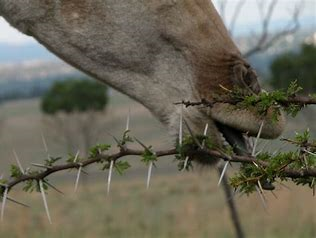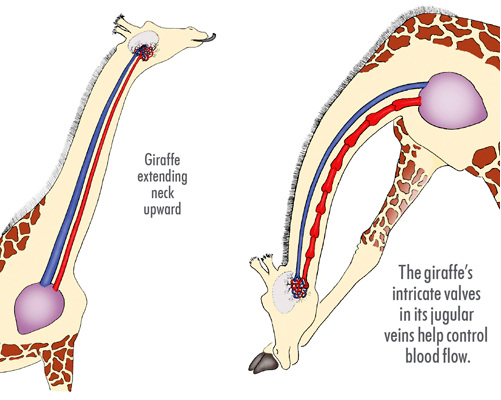Giraffe News and Facts will share facts about the world’s tallest land animal. It will also include the latest news on giraffes. These are fascinating animals that from an evolutionary standpoint, are somewhat of an enigma. They have a unique anatomy that appears designed specifically for the Giraffe (Giraffa Camelopardalis). Hence, a design that could not have developed over long periods of time, according to the fossil record.
Giraffe Life Cycle News and Facts
The female giraffe has a 15-month gestation period. Consequently, after the 15-month gestation, the giraffe has a spectacular birth. Since the giraffe gives birth standing up, the newborn calf falls more than five feet to the ground. They survive this fall because the calf is nearly six-feet tall at birth. Also, within about 15 minutes after the calf is born, it stands up. Soon after that, it begins to walk and then run. Being vulnerable to predators, during their first few months of life, half of the giraffe calves do not survive their first year. Once they reach maturity giraffe can live 20-25 years in the wild.

Giraffe Size
Giraffes are the tallest land animals. Calves are born almost 6 feet tall. Adults can reach 16-19 feet tall. The males are taller and heavier than the females. The males can weigh between 2,400 to 3,000 pounds, the females 1,600 to 2,600 pounds. So, these very tall and heavy creatures can easily see predators coming from long distances and have large eyes and good vision. But this height and weight require specialized anatomical features.
Giraffe Design and Adaptations
Let’s start at the top and go down. First, they have two skin-covered horns on top of their heads to protect their skulls during occasional fighting. They forage among acacia trees, using their 20-inch tongues to pluck off the leaves and twigs. Also, their blackish tongues are prehensile, so they can clutch things with their tongues. So, these tongues and the giraffe’s lips are even impervious to the thorns of the acacia tree. As the world’s tallest ruminants, giraffes chew their cud like a cow. So, they regurgitate half-chewed food, chew them again and re-swallow the food as it travels through their four-chambered stomach.

Giraffe Neck Design
Their amazing neck is long and powerful. Consequently, this 500-pound (225 kilograms) structure enables the giraffe to reach foliage that other species can never reach. Interestingly, their Neck contains just seven cervical vertebrae. Just like humans have only 7 cervical vertebrae. But, theirs is bound together with ball-and-socket joints. Similar to our shoulder joints, which gives them a vast range of motion. Vertebral extensions allow for a very large ligament. It’s called the nuchal ligament, which runs from the back of the skull all the way down to the base of the tail. The thickest portion is just over the shoulders. So, this ligament helps counteract the weight of the giraffe’s head and neck, acting like a giant rubber band, pulling the neck up.
Unique Circulatory Design
The giraffe has the largest heart of any land animal. It can be 2 ft long in an adult male and weigh up to 24 pounds. Hence, it generates a blood pressure about twice that of a human or other large mammal. Consequently, the artery walls have extra elasticity to ensure that they can handle this high pressure. Furthermore, to prevent the blood from rushing too quickly back down the neck again, the jugular veins in the neck partially contract to restrict return blood flow.
So, this is all good if the giraffe is walking around with its head up, but what happens when it wants to take a drink? When the giraffe lowers its head, the heart is still pumping and gravity is assisting the blood flow. So, all that high-pressure blood should rush downhill and blow out the delicate blood vessels in the brain and eyes killing the giraffe.
Why doesn’t the Giraffe blow its mind and shoot the eyes out of its head when it bends over to drink?
First, the giraffe must spread his front legs apart in order to drink comfortably. This lowers the level of the heart somewhat and so reduces the pressure from the heart to the head as the animal drinks. So, there is less pressure in the brain.
Second, the giraffe has one-way check valves in its jugular veins which immediately close as the head is lowered, thus preventing blood from flowing back down into the brain. But what about the blood flow that is continuing to pump through the carotid arteries to the brain?
Third, is a design feature, unlike any other animal. It is the vascular net, a spongy tissue filled with numerous small blood vessels located near the base of the giraffe’s brain. The arterial blood has to flows through this net of vessels before it reaches the brain. The net controls the blood flow by gently expanding to accommodate the increased local blood pressure. Hence, the giraffe doesn’t pass out or drop dead.

Other Interesting Giraffe News and Facts
The giraffe can gallop for a short time at speeds of about 34-38 miles per hour. Its front legs are about 10% longer than the hind legs. The giraffe also has special adaptations for its legs. Combined with the effect of gravity on such a tall body, the animal would bleed profusely from any cut without these special adaptations. Fortunately, the skin on the giraffe’s legs is extremely tight and has tightly fitted inner fascia. Consequently, this has been studied by NASA scientists developing the “gravity-suits” worn by astronauts that help maintain correct circulation while in space.
Also, the giraffe eats an estimated 140 pounds of leaves and twigs per day. The cows or female giraffes feed their young from an udder with 4 tits, similar to a dairy cow. Giraffes are not endangered but have a declining stable population. Also, new research indicates that they may communicate through infrasonic sounds. Frequencies below the lower limit humans are able to hear.
Giraffe News and Facts “NEWS”
April the Giraffe has once again made the news with the birth of a male offspring on Saturday the 16th of March in Harpursville, New York. April rose to fame in 2017 as the world watched a live feed and waited for her to give birth to a male giraffe. The Male giraffe named Tajiri was born at the Animal Adventure Park in Harpursville, New York State in 2017.
Hundreds of thousands of viewers around the world watched as April gave birth on her live webcam on Saturday. April gave birth to another male giraffe that morning. Hence, this calf was April’s fourth calf. April gave birth at 11 a.m. and by 2 p.m., the new baby boy was walking around and nursing, according to park officials. This baby stands 5 foot 11 inches tall and weighs 139 pounds, which is a very healthy height and weight for a new calf.
Giraffe News March 11, 2020
World’s Only White Female Giraffe and Her white Calf Were Killed by Poachers.
According to India.com Buzz Desk, At Kenyan Wildlife Sanctuary in Nairobi: A white female giraffe and her calf, believed to the last of their kind in the world, have been killed by poachers. They died in a wildlife sanctuary in eastern Kenya. Rangers at the Ishaqbini Hirola Conservancy on Tuesday confirmed the news. The remains of two stunning white giraffes in a Kenyan wildlife sanctuary were found in a skeletal state. The following statement also added the animals had been killed by armed poachers.
“This is a very sad day for the community of Ijara and Kenya as a whole. We are the only community in the world who are custodians of the white giraffes,” Mohammed Ahmednoor, manager of the reserve in Garissa County, Kenya, said in a press release.

References
The Animal Foundation. (n.d.). GIRAFFE FACT SHEET. Retrieved from The Animal Foundation. (n.d.). GIRAFFE FACT SHEET.
Hofland, L. (1996, September). Giraffes … animals that stand out in a crowd.com.
Pitman, D. (2011, October). Giraffe neck design.com.
Strub, C. (2019, March 18). ‘It’s a boy!’ – April the Giraffe Gives Birth.


